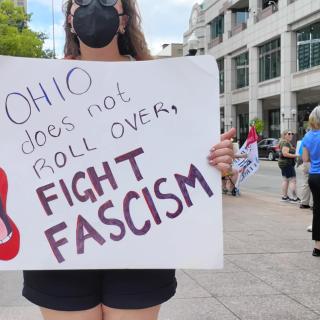Advertisement
Earlier this year when Kaufman Development sold one of its “Gravity” apartment buildings in Franklinton, it was another canary-in-the-coal mine moment for a West Side activist. Just a month prior, the Columbus-based developer had sold the nearby Idea Foundry and Gravity Park Experience, which is best described as a playground for adults with its pickle ball courts.
“They are cheap-ass apartments from what we’ve seen at Gravity,” says Rebecca Hunley, a Franklinton homeowner and also the current chair of the Franklinton Area Neighbors Civic Association, an organization she founded. “Yet I don’t see anything telling me, or anybody from our neighborhood, we can move in. I have never paid a mortgage like what they are asking for rent. Gravity, the great flop that it is. It’s a failure.”
Kaufman Development’s efforts to rehab and redefine this area of Franklinton was much ballyhooed by the community and local media. And a phoenix of mixed-use did arise from the dilapidation and parking lots. But after just two years Kaufman has sold most of it away, and it took a City of Columbus and taxpayer funded nonprofit, the Columbus Next Generation Corporation, to save the Idea Foundry and Gravity Park Experience.
Kaufman Development in this area still owns the mixed-use apartment building at 500 W. Broad Street. They weirdly describe it as such: “Welcome to the world’s largest conscious community – designed with intentionality, creativity and purpose. Curated to uplift those who choose it for living, working, or exploration.”
But there’s one very stressful challenge for many in Franklinton and most of Columbus for that matter: the exorbitant cost to live here. And why Kaufman may end up selling this building as well. At this location a “null bedroom” – meaning the bedroom and living room are combined into one room – is going for $1,375 a month and plenty are available.
“Who are they going to rent these apartments to is what everybody is dying to know?” asks Hunley. “Who are these people? Where are the jobs, that as a single person, you make that kind of money? That one-quarter or 35 percent of your income is devoted to housing.”
Hunley argues that Kaufman’s Gravity in many ways is a precursor to how LinkUS and Zone In could change the West Side, and it was no surprise to her both passed in the same year, that being 2024. To be clear, both could radically alter Columbus physically and culturally. The question asked by some is: For better or for worse?
Put succinctly, Zone In was passed by City Council so to create greater density. Making it easier to build taller apartments or condos along the city’s main corridors with minimal to no parking requirements. LinkUS was passed by voters and promises to solve Columbus’s transit challenges with “Bus Rapid Transit” or BRT lines (accordion buses in dedicated lanes). Construction on West Broad’s $340 million BRT line is scheduled to begin next year.
Hunley believes LinkUS will only be successful if there’s enough ridership, and LinkUS will not be successful without Zone In.
“We don’t have ridership on the West Side to do anything. There’s no basis for LinkUS whatsoever. And if you are actually going to have a bus line that does something, you can start in Springfield,” she said. “COTA will need customers for LinkUS, and Zone In is the official key to the city to the developers from the city.”
According to those who fully support LinkUS and Zone In, together they will improve public transportation and encourage more development. But what type of housing? More high-end apartments and condos, or affordable workforce housing?
Interesting is what was told to the local landlord lobbyist group the Columbus Apartment Association during a general meeting back in February. Andrew Mazak of Vogt Strategic Insights told an estimated 100 landlords that vacancies are highest amongst the newer high-end product.
“With all the new apartments coming online over the past two years we actually saw an increase in vacancies,” he said, adding, “Consequently, the percentage rent increase was the greatest among the B projects.”
“We can’t build all high-end, expensive, market rate product. There needs to be product for those who are public servants, teachers, general work-force housing,” he said.
Hunley says up the street from Gravity at the former Mount Carmel West campus, most of the housing being built is high end with developers incentivized through property tax abatements. All of Columbus is now a Community Reinvest Area (or CRA), but for Franklinton, its CRA designation does not require affordable housing to earn the 100 percent, 15-year abatement.
“We are building all the same kind of housing to alleviate the so-called ‘housing crisis’,” she says. “The 44 people coming to Franklin County every day is a lie. And even if they were, do you think all of them are single people looking for 44 homes? I doubt it. I’m thinking they’re probably families. We have hundreds of vacant homes in Franklinton, by the way.”
Zone In solves no housing problems in Franklinton or on the Hilltop, she says, because these rents are outside anything these residents can afford.
“Apartments from $1,200 to $1,600 a month? They are basing that on the Franklin County AMI (Average Median Income) of $74,000. The AMI in Franklinton is $35,000. It does not solve the housing shortage, nor does it solve the housing crisis for those who do need affordable housing.”



